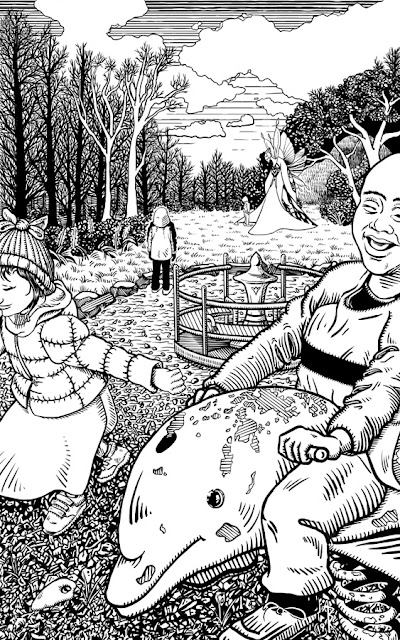The second part in the "Flashlight, Knife and Flowered Crown" serial, written by Sarah Avery, has now been published in Space and Time Magazine issue #135 (Dec, 2019).
In the first illustration, I tried to capture the terror of having your child abducted by faerie. Here in the second illustration, I try to convey the gravity of that threat. The Fae do not take great care of their child-pets and dispose of their emaciated and mummified corpses in one of many vaults with their other broken treasures. Our hero must transverse one such vault on her journey into the faerie barrow to rescue her son.
 |
| Character sketch of our heroine in detail. |
I decided to pull away from the characters and feature the room (that horrifying room). I will note that we are getting closer to the Fae characters as the illustrations progress.
 |
| For a while I tried to feature the bearded dragon in the foreground, but couldn't get it to work. |
One of the difficulties of working at this detail level is trying to make the illustration simple enough that it reads at the published 6x4 inch size. At last count, there were 72 tiny kiddie corpses in this illustration, then I added a few more where they were needed. Grandma always said you should never be stingie when sprinkling the landscape with malnourished infants and preteens. Each child is unique. Nina is there. Many have their own brief backstories.
I'll briefly share one such story.
--One of the children, one of the most beautiful the faerie had ever taken, had autism. This child refused to drink the nectar fed them, finding the texture beyond aversive. The nectar is what magically preserves the bodies of the children, and without it this child's has faded to nothing but bones.--
Sarah's story has elements of enchanted items, objects with attitudes and personality, and for the most part I never planned to feature this in any of the three illustrations but I was just able to hint at it here by putting frumpy faces into the background pillars.
I think I may have figured out why the children call him Toady.
Also scattered about are a number of broken art treasures from throughout mankind's history, from the Olmec to the Egyptians to pre-historic Peruvian Chancay dolls. Sarah and her family keep pet dragons and I thew a bearded one in for them (the fat rodent, however, is just there for a quick lunch).
 |
| For the illustrator, the most important words in the story. |
Here too we begin seeing the transition I mentioned in my blog about Part 1; a transition into the textiles and shapes of the Fae world as we stand just outside the doorway to their realm. Next illustration should feature these type of forms prominently with the human characters maintaining the style established in the first two. We'll see if it all works.













